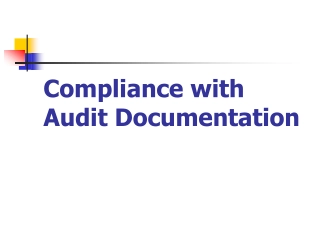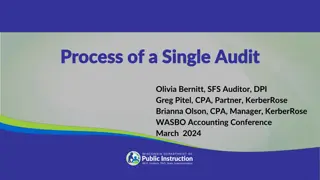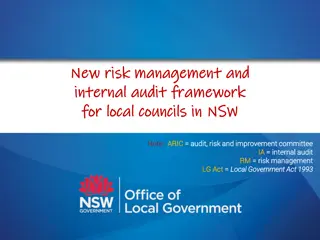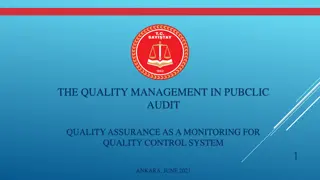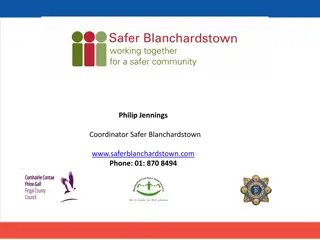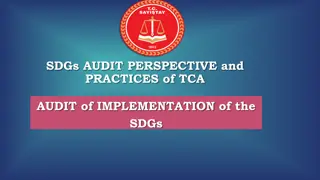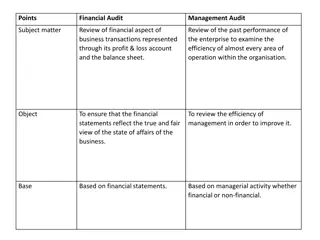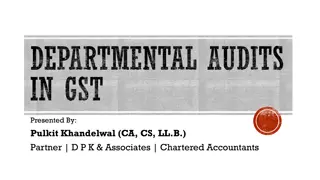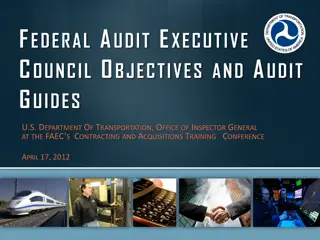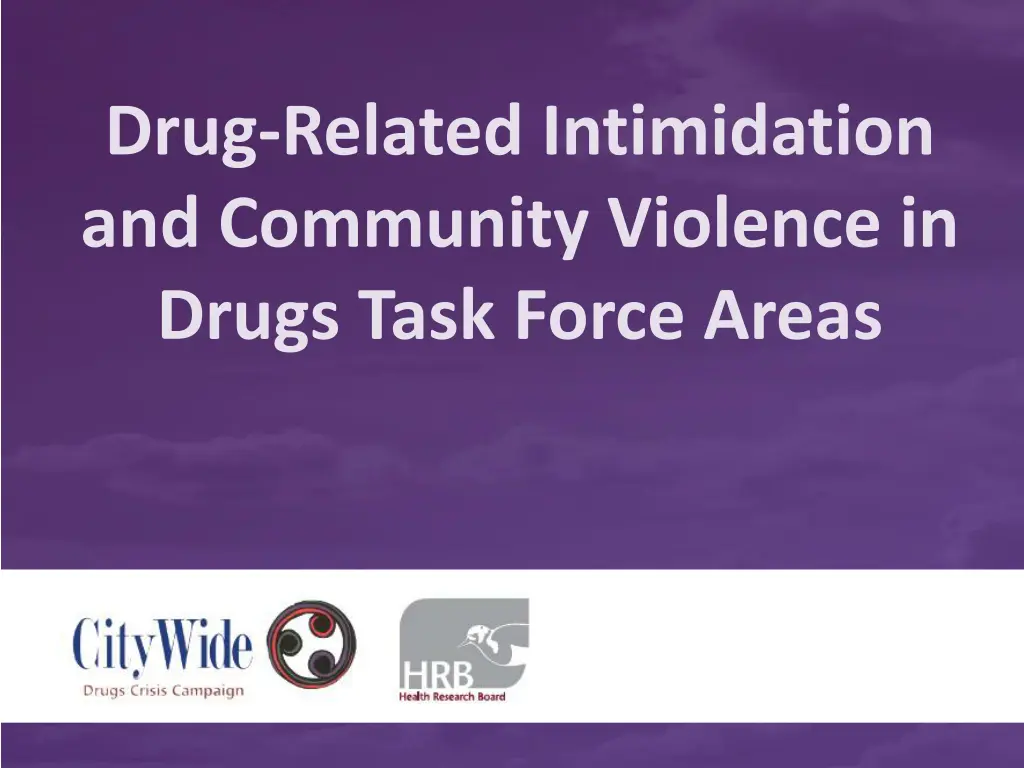
Understanding Drug-Related Intimidation and Community Violence in Task Force Areas
Explore the hidden experience of drug-related intimidation on a national level, aiming to raise awareness among policymakers and the public while supporting communities in developing effective responses. This research delves into key areas for investigation without providing direct solutions.
Download Presentation

Please find below an Image/Link to download the presentation.
The content on the website is provided AS IS for your information and personal use only. It may not be sold, licensed, or shared on other websites without obtaining consent from the author. If you encounter any issues during the download, it is possible that the publisher has removed the file from their server.
You are allowed to download the files provided on this website for personal or commercial use, subject to the condition that they are used lawfully. All files are the property of their respective owners.
The content on the website is provided AS IS for your information and personal use only. It may not be sold, licensed, or shared on other websites without obtaining consent from the author.
E N D
Presentation Transcript
Drug-Related Intimidation and Community Violence in Drugs Task Force Areas
Research Origins 2011 seminar on intimidation 2012 Citywide Policy Document: committed Citywide to pursuing concrete proposals for a co-ordinate response 2013 seminar: research proposal by Johnny Connolly from Health Research Board
Research Aims To access the hidden experience of drug-related intimidation nationwide Highlight the situation to policy makers and the wider public To assist communities in developing locally based, effective, and sustainable responses This audit raises questions for discussion, not solutions: what are key areas that we need to investigate.
Process All Local and Regional Drug Task Forces were invited to participate. Incident report forms sent to 13 Drugs Task Forces. Total of 140 incidents reported Six focus groups: Travellers, Ex prisoners, Family Support, Drugs Task Force
Summary of key findings
Q4 Approximate time of day when incidents occurred: 16% 25% 46% 24%
Q6: Who is the intimidation or violence directed at? 75% 12% 33% 13% 12% 7% 4% 1% 2% 3%
Q8 Who reported the incidents? 50% 39% 4% 4% 5% 1% 1% 1% 1% 1% 1% 1%
Q.9 Reported reasons behind the intimidation or violence: 52% To frighten 74% To reclaim drug debt To obtain money (extortion) 17% To reclaim illegal money lending debt To enforce gang control 7% 13% To enforce silence regarding drug dealing 7% 4% To enforce silence regarding other illegal activities To recruit into illegal activities 7% Reasons unknown 2%
Q7. Nature of the incidents: 76% 46% 32% 6% 10% 9% 1% 1% 1%
Escalation from verbal to physical Repeated incidents go on for months A campaign of terror that causes stress and despair for families Puts great strain on project workers who are doing a difficult job with lack of resources Coercion and entrapment: assisting dealers activities, storing and delivering drugs and weapons
Q.10 If drug-related, how much money was involved? 3% 18% 21% 26% 13% 9% 10%
Q.11 - Gender and approximate age of those carrying out incidents: 13% 15-17 Male: 81% 38% 18-25 26-35 Female: 19% 48% 21% Over 35 15-17 11% Groups: 70% 44% 18-25 Individuals: 30% 44% 26-35 19% Over 35
Q. 12 What action did victims/families take in response to the incident? 30% 45% 17% 21%
Q. 13 If the victim/family previously reported the incident, who did they report it to? 32% 6% 28% 61% 2% 2% 3%
Q. 15 If they didnt report it to Gardai, why not? 50% 44% 29% 74% 4%
Q.16 Consequences of incident: Health/Wellbeing Mental Health Issues 67% Other Health Issues 30% Physical Injury 37% Sexual Harm Permanent Disfigurement 4% 1% Suicide 2% Death
Home and Family Family/Relationship breakdown 48% Fear for children s safety 43% Fear for personal safety at home 70% Temporarily leave home 21% Permanently leave home 17% Homelessness 8% Finance Money problems 56% Engaged in illegal activities to repay drug debts 28%
Work Increased workplace stress 12% Fear for personal safety in work 9% Left employment due to fear 8% Social 67% Fear for safety in local area Avoid certain areas 59% Avoid certain people/families 54% Social Isolation 34% Forced to engage in illegal activities 20%
Focus Groups Emerging themes from analysis of focus group data...
Victims and Perpetrators Debt has to be paid, fear and respect generates income There is a large middle group who maintain control Intimidating families is a way of flushing the drug user out
The victims can also be perpetrators; harass and/or threaten family members to pay debts. Drug users are intimidating vulnerable people to pay for their own drugs. Dealers who source drugs on credit are under threat from suppliers, threat is passed on to customers/users: hierarchy of coercion
Young People Young people are getting into huge debt over weed; coerced into working the debt off There is intimidation in schools as young people are geographically far from each other outside of school. This is treated as bullying but nothing much is being done about it. Fear of attack over debts is a cause of early school leaving. Some young people carry weapons to school.
How can schools best respond? What procedures are in place? Young people in the area have been forced to hold drugs. They have been caught by Gardai, they then have a bill to pay. Youth and community workers notice behavioural changes in young people; hear stories about victimisation; self harm; suicide attempts Some young people are anxious about family members who are taking drugs and being intimidated
Reporting Youth workers feel their hands are tied because parents tell them about intimidation and they don t know if they should tell them to go to the Gardai, pay up or face the consequences. There is a belief that nobody can do anything including the Guards. They know that if someone goes to prison they will get back out quickly.
Protection fear Some parents will contact projects or groups but don t want it to go further. Fear of reprisal is stopping people from reporting intimidation Workers are afraid to speak with gardai about threats or violence that has been directed against them
Finances People are struggling to pay debts and using loan sharks. People have sold their houses to pay off drug debts and can t get on to social housing lists because the Council believe that they should have the proceeds of the sale to pay for accommodation. Interest or waiting money is widespread; Debts can be sold on to collectors so payment increases
Parents get a variety of responses depending on who is intimidating them. Paying can perpetuate the problem. Incidents are ongoing where families pay a debt and then drugs are offered to users on credit again because they know they will pay and another debt is accrued. Families are paying debts even when no direct threat: consequences for non payment are clear
Community Some flat complexes are no go areas. Staff feel threatened but won t report. Many in the community view the community workers as rats and they often feel intimidated going to work. The situation has had effects on community involvement. Fear prevents participation. Non drug related crimes are not reported because the perpetrator may be part of a gang; fear of reprisal from drug dealers.
Conclusions Fear of reprisal was the number one reason for not reporting; not reporting as the number one theme from the audit. Demonstrates how drug crime is mediated by social class, poverty and deprivation. In most communities surveyed in nationwide victimisation polls non reporting of crime is rarely because of fear of reprisal. Huge challenge for community policing. How should the State respond: community safety structures require resources.
The social, emotional, and psychological stress that drug debt and the violent attention of dealers causes in the midst of poverty, disadvantage, austerity, and unemployment, needs to be emphasised in the strongest possible terms. Top down system of enforcement where predatory individuals are making great profits. Dominant drug dealers have tremendous power and communities are at a loss. People feel helpless. The power has to shift.

